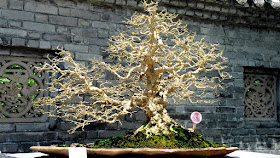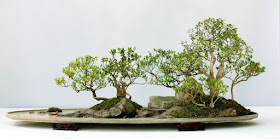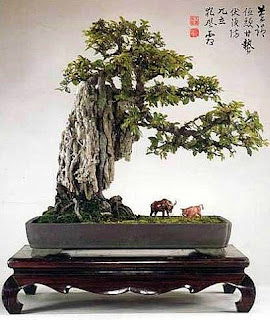The Chinese Bonsai is called Penjing, also known as penzai, is the ancient Chinese art of depicting artistically formed trees, other plants, and landscapes in miniature.
Penjing generally fall into one of three categories:
Shuihan penjing (水旱盆景): A water and land penjing style that effectively combines the first two, including miniature trees and optionally miniature figures and structures to portray a landscape in detail.
Similar practices exist in other cultures, including the Japanese traditions of bonsai and saikei, as well as the miniature living landscapes of Vietnamese hòn non bộ. Generally speaking, tree penjing specimens differ from bonsai by allowing a wider range of tree shapes (more "wild-looking") and by planting them in bright-colored and creatively shaped pots. In contrast, bonsai are more simplified in shape (more "refined" in appearance) with larger-in-proportion trunks, and are planted in unobtrusive, low-sided containers with simple lines and muted colors.
While saikei depicts living landscapes in containers, like water and land penjing, it does not use miniatures to decorate the living landscape. Hòn non bộ focuses on depicting landscapes of islands and mountains, usually in contact with water, and decorated with live trees and other plants. Like water and land penjing, hòn non bộ specimens can feature miniature figures, vehicles, and structures. Distinctions among these traditional forms have been blurred by some practitioners outside of Asia, as enthusiasts explore the potential of local plant and pot materials without strict adherence to traditional styling and display guidelines.
Guangdong and Guangxi provinces, in particular, have a strong tradition of penjing. These regions have a subtropical climate that allows for the cultivation of a wide variety of plant species, including many that are suitable for penjing. Additionally, the lush natural scenery and landscapes of southern China have inspired and informed the artistic expression of penjing.
Other regions in southern China, such as Fujian and Jiangsu, also have notable penjing traditions. These traditions may vary in terms of style and the specific plant species used, but they all share the common goal of creating miniature natural landscapes in containers.
While penjing is popular in southern China, it is not limited to this region. The art form is practiced and appreciated throughout the country and has gained international recognition as well. Each region may have its own distinct style and approach to penjing, reflecting the local environment and cultural influences.
What is the difference between Chinese bonsai and a Japanese bonsai tree?
Basically, a Japanese bonsai tree appears a little more formal than a Chinese penjing. Even Japanese bonsai containers are usually more subtle, in both color and design. So that is the very basic difference. You rarely, if ever, see rocks or figurines in Japanese composition.
Chinese bonsai has always fascinated me. (Perhaps that's the reason, bunjin aka literati is one of my favorite "bonsai" styles.) It wasn't until I read Karin Albert's 'Penjing: A Chinese Renaissance several years ago that I grasped a deeper meaning and genuine differences. She wrote a beautifully worded, thorough article on the subject for the Art of Bonsai blog.
Frequently, designs appear bolder, livelier, and more playful, sometimes even bizarre. By contrast, a Japanese bonsai tree tends to look neater and more formalized. Regarding the latter, there is a greater sense of control; the viewer gets the feeling that not even the most minute detail has been left to chance. The minimalism of many Japanese designs can feel comforting and safe, but it also produces a high degree of predictability.
By and large, it seems that Japanese artists have a strong tendency to impose order on their creations, whereas Chinese artists appear willing to embrace a measure of chaos. Clearly, they are less concerned with rules and the pursuit of perfection. Does it mean that there are no rules in penjing at all? Absolutely not. Conversations with penjing artists reveal that they are less interested in displays of technical virtuosity and ideal form. Instead, they seek to capture and convey sentiment and mood in their work. Their goal is to reveal an inner beauty, an essence inherent in nature.
Famous Bonsai producers in China include the Shanghai Botanic Gardens whose mission is preventing plant extinction and educating people. With over 150 Bonsai gardens, Suzhou is believed to have the loveliest Bonsai gardens in China. One of Suzhou’s many gardens, the Humble Administrators Garden, is listed as a World Heritage Site. The Hangzhou Flower Nursery in Zhejiang is famous for its two-and-a-half acre Bonsai garden that includes 3,500 Bonsai plants.
Classifications
Chinese Bonsai can be classified into several groups including size, the province from which they are derived and the type of Bonsai. Although Chinese Bonsai comes in many sizes, Chinese Rock Bonsai stands out because they are available from just a few centimeters in height up to two meters in height. Provinces throughout China have their own genres, or schools, of Bonsai. Among them are the Suzhou School (featuring 'Tree Branches Overhanging a Cliff'), the Zhejiang School (featuring 'Tall Trunk'), the Sichuan School (featuring 'Reclining and Slanting Trunk'), the Hunan School (featuring 'Hanging Cliff'), the Hubei School (featuring 'Flat-Top'), the Liaoning School (featuring 'Earthworm Curves'), the Beijing School, the Shanghai School, and the Lingnan (Guangzhou) School. Types of Bonsai include tree Bonsai, landscape Bonsai, flower Bonsai, plant Bonsai, and rock Bonsai.
Care and Maintenance
Bonsai plants need regular care just like other plants. Watering, fertilizing, trimming and the occasional re-potting (every three years or when the roots are bound) will ensure that the Bonsai is healthy and lives long. The art of Bonsai takes patience and diligence but with proper care, a Bonsai will repay the owner many times over. Transforming a small tree can transform your life.

Interesting Books on Bonsai can be found here:
The Complete Book of Bonsai --> I've been into bonsai for 25 years and this is the basic Bible for beginner and intermediate bonsai enthusiasts. It has an excellent section on techniques, including pruning, wiring, and whatnot, and it has a large species-specific tree guide. If you're into bonsai and want only one book, this is it.
Indoor Bonsai The Great Selection --> Creating beautiful, healthy bonsai is a wonderful skill that anyone can learn, with a little time, patience, and this all-inclusive manual. With color photos and drawings to illustrate the points, it introduces all the cultivation techniques; offers expert advice on location, soil types, watering, and pest control; and provides intricate instruction on training the bonsai--including pruning, wiring and stretching it.
The Secret Techniques of Bonsai --> In The Secret Techniques of Bonsai, the author of the groundbreaking Bonsai With American Trees teams up with his son to offer not only the basics for creating perfect bonsai but also secret techniques they’ve developed over years of careful work and observation.
Bonsai Survival Manual --> Problem solving when your Bonsai get sick. Expand your gardening repertoire as you create a captivating and exquisite miniature world. In this introductory guide, Colin Lewis covers everything you need to know to design, grow, and successfully maintain attractive bonsai.
Bonsai and the art of Penjing --> Bonsai & Penjing, Ambassadors of Beauty and Peace describe how Chinese penjing and North American bonsai were later added to the Museum, making its collection the most comprehensive in the world. Stories of individual trees and forest plantings are featured, as are the roles played by the skilled and talented creators of these living art forms people such as John Naka, Saburo Kato, Yuji Yoshimura, Harry Hirao, and Dr. Yee-Sun Wu.
Bonsai and the art of Penjing --> Bonsai & Penjing, Ambassadors of Beauty and Peace describe how Chinese penjing and North American bonsai were later added to the Museum, making its collection the most comprehensive in the world. Stories of individual trees and forest plantings are featured, as are the roles played by the skilled and talented creators of these living art forms people such as John Naka, Saburo Kato, Yuji Yoshimura, Harry Hirao, and Dr. Yee-Sun Wu.
Bonsai with Japanese Maples --> With their delicate foliage, seasonal color changes, and intricate pattern of branching, Japanese maples are among the most popular and suitable plants for bonsai design. In this long-awaited book, internationally renowned expert Peter Adams discusses both the specific horticultural needs of Japanese maples as bonsai subjects and illustrates proven techniques for creating and maintaining beautiful specimens.
The Modern Bonsai Practice --> The most current, useful information on growing Bonsai. A fresh, practical, definitive, comprehensive reference guide to the finest art of horticulture: growing miniature trees. Common sense bonsai answers separating myth from fact with depth and detail. Appropriate for both bonsai hobbyists and experienced practitioners.

More Bonsai articles can be found here:
Please click here for more information on --> Chinese Penjing Bonsai
Please click here for more information on --> The Origins of Bonsai
Please click here for more information on --> The Art of Saikei Bonsai
Please click here for more information on --> Japanese Tanuki Bonsai
Please click here for more information on --> How to Water a Bonsai
Please click here for more information on --> Bonsai Healing Methods





No comments:
Post a Comment